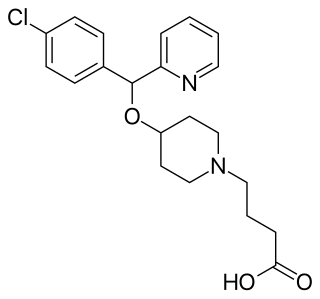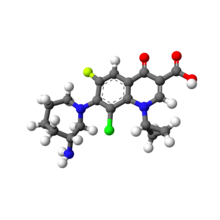
Conjunctivitis, also known as pink eye, is inflammation of the outermost layer of the white part of the eye and the inner surface of the eyelid. It makes the eye appear pink or reddish. Pain, burning, scratchiness, or itchiness may occur. The affected eye may have increased tears or be "stuck shut" in the morning. Swelling of the white part of the eye may also occur. Itching is more common in cases due to allergies. Conjunctivitis can affect one or both eyes.

Ophthalmology is a surgical subspecialty within medicine that deals with the diagnosis and treatment of eye disorders.

LASIK or Lasik, commonly referred to as laser eye surgery or laser vision correction, is a type of refractive surgery for the correction of myopia, hyperopia, and an actual cure for astigmatism, since it is in the cornea. LASIK surgery is performed by an ophthalmologist who uses a laser or microkeratome to reshape the eye's cornea in order to improve visual acuity.

Levofloxacin, sold under the brand name Levaquin among others, is an antibiotic medication. It is used to treat a number of bacterial infections including acute bacterial sinusitis, pneumonia, H. pylori, urinary tract infections, chronic prostatitis, and some types of gastroenteritis. Along with other antibiotics it may be used to treat tuberculosis, meningitis, or pelvic inflammatory disease. Use is generally recommended only when other options are not available. It is available by mouth, intravenously, and in eye drop form.

Dry eye syndrome, also known as keratoconjunctivitis sicca, is the condition of having dry eyes. Symptoms include dryness in the eye, irritation, redness, discharge, blurred vision, and easily fatigued eyes. Symptoms range from mild and occasional to severe and continuous. Dry eye syndrome can lead to blurred vision, instability of the tear film, increased risk of damage to the ocular surface such as scarring of the cornea, and changes in the eye including the neurosensory system.

Allergic conjunctivitis (AC) is inflammation of the conjunctiva due to allergy. Although allergens differ among patients, the most common cause is hay fever. Symptoms consist of redness, edema (swelling) of the conjunctiva, itching, and increased lacrimation. If this is combined with rhinitis, the condition is termed allergic rhinoconjunctivitis (ARC).
The Lions Eye Institute (LEI) is an Australian medical research institute affiliated with the University of Western Australia. It was established in 1983 with support of the Lions Clubs of Western Australia and headquartered in the Perth suburb of Nedlands, Western Australia. The LEI is a not-for-profit centre of excellence that combines an ophthalmic clinic with scientific discovery developing techniques for the prevention of blindness and the reduction of pain from blinding eye conditions.

Corneal cross-linking (CXL) with riboflavin (vitamin B2) and UV-A light is a surgical treatment for corneal ectasia such as keratoconus, PMD, and post-LASIK ectasia.

Loteprednol is a topical corticosteroid used to treat inflammations of the eye. It is marketed by Bausch and Lomb as Lotemax and Loterex.
Ocular ischemic syndrome is the constellation of ocular signs and symptoms secondary to severe, chronic arterial hypoperfusion to the eye. Amaurosis fugax is a form of acute vision loss caused by reduced blood flow to the eye; it may be a warning sign of an impending stroke, as both stroke and retinal artery occlusion can be caused by thromboembolism due to atherosclerosis elsewhere in the body. Consequently, those with transient blurring of vision are advised to urgently seek medical attention for a thorough evaluation of the carotid artery. Anterior segment ischemic syndrome is a similar ischemic condition of anterior segment usually seen in post-surgical cases. Retinal artery occlusion leads to rapid death of retinal cells, thereby resulting in severe loss of vision.

Nicox S.A. is a French ophthalmology company developing treatments to maintain vision and improve ocular health. Nicox is headquartered in Sophia Antipolis, France, and its Chairman and CEO is Michele Garufi.

Bromfenac is a nonsteroidal anti-inflammatory drug (NSAID) marketed in the US as an ophthalmic solution by ISTA Pharmaceuticals for short-term, local use. Prolensa and Bromday are the once-daily formulation of bromfenac, while Xibrom was approved for twice-daily administration. In the European Union, the brand name is Yellox. Bromfenac is indicated for the treatment of ocular inflammation and pain after cataract surgery.

Bepotastine is a 2nd generation antihistamine. It was approved in Japan for use in the treatment of allergic rhinitis and urticaria/pruritus in July 2000, and January 2002, respectively. It is marketed in the United States as an eye drop under the brand name Bepreve, by ISTA Pharmaceuticals, a subsidiary of Bausch + Lomb.

ISTA Pharmaceuticals, Inc, was a US-based pharmaceutical company that specialized in ophthalmic pharmaceutical products and discovers, develops, and markets therapies for inflammation, ocular pain, glaucoma, allergy, and dry eye. ISTA was acquired by Bausch & Lomb, an eye care company, on March 26, 2012. Under the deal, Bausch & Lomb have agreed to pay $9.10 per share for ISTA, bringing the total value of the acquisition to $500 million.

Mapracorat is an anti-inflammatory drug belonging to the experimental class of selective glucocorticoid receptor agonists (SEGRAs). It is in clinical trials for the topical treatment of atopic dermatitis, inflammation following cataract surgery, and allergic conjunctivitis. Preliminary investigation for the treatment of keratoconjunctivitis sicca has been conducted in cellular models.

Alimera Sciences, Inc. is a biopharmaceutical company based in Alpharetta, Georgia that specializes in the commercialization and development of prescription ophthalmic pharmaceuticals. The company's main focus is on diseases affecting the back of the eye, or retina. Its main product is Iluvien, a fluocinolone acetonide intravitreal implant.
Diffuse lamellar keratitis (DLK) is a sterile inflammation of the cornea which may occur after refractive surgery, such as LASIK. Its incidence has been estimated to be 1 in 500 patients, though this may be as high as 32% in some cases.
Peter S. Hersh is an American ophthalmologist and specialist in LASIK eye surgery, keratoconus, and diseases of the cornea. He co-authored the article in the journal Ophthalmology that presented the results of the study that led to the first approval by the U.S. Food and Drug Administration (FDA) of the excimer laser for the correction of nearsightedness in the United States. Hersh was also medical monitor of the study that led to approval of corneal collagen crosslinking for the treatment of keratoconus.
Marguerite McDonald is an eye surgeon who in 1987 performed the first excimer laser treatment. In 1993 she became the first to use this treatment to treat farsightedness. In September 2003, she became the first person in North America to perform Epi-LASIK. She has also conducted the first wavefront-based laser surgeries in the United States. She was a co-developer of Kaufman-McDonald epikeratophakia.
Post-LASIK ectasia is a condition similar to keratoconus where the cornea starts to bulge forwards at a variable time after LASIK, PRK, or SMILE corneal laser eye surgery. However, the physiological processes of post-LASIK ectasia seem to be different from keratoconus. The visible changes in the basal epithelial cell and anterior and posterior keratocytes linked with keratoconus were not observed in post-LASIK ectasia.















